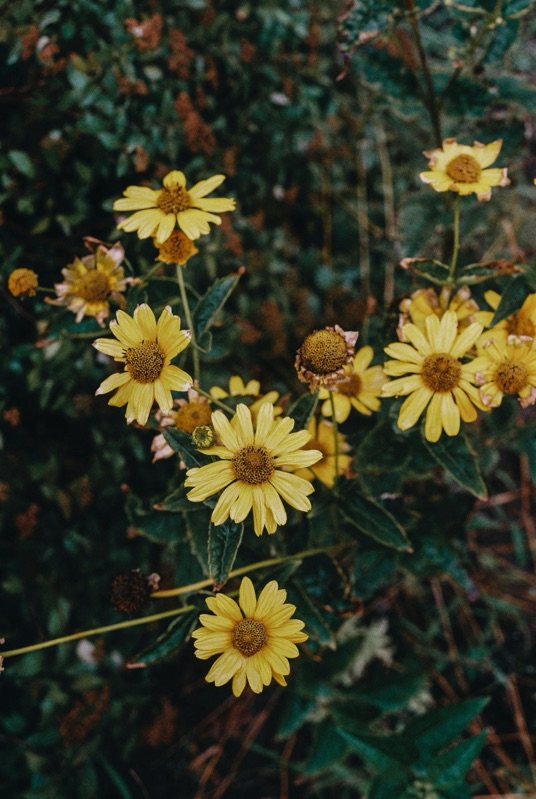Botanical Basics
- Common Name(s): Arnica, Mountain Tobacco, Leopard’s Bane, Wolf’s Bane
- Folk Name(s): Mountain Daisy, Fall Herb, Wound Herb
- Scientific/Latin Name: Arnica montana (most commonly referenced medicinal species)
- Family: Asteraceae (Daisy family)
- Plant Type: Perennial herb
- Botanical Description: Arnica has bright yellow, daisy-like flowers with 10–15 petals surrounding a darker orange-yellow center. Leaves are green, opposite, and oblong or spatulate, with a hairy texture. Stems grow 20–60 cm tall.
- Growing Zones/Climate: USDA Zones 4–9; prefers cool, mountainous, alpine, or subalpine climates.
- Best Zones for Growth: Northern and Central Europe, higher elevations in temperate regions.
- Habitat & Range: Native to Europe (notably the Alps, Pyrenees, and Carpathians); also naturalized in parts of North America.
Cultivation & Harvest
- Soil & Sun Requirements: Well-drained, slightly acidic to neutral soil (pH 6–7); full sun to partial shade. Prefers sandy or loamy soils.
- Propagation: Primarily from seed or root division. Seeds require stratification (cold exposure) for better germination.
- Companion Planting: Grows well near other alpine herbs; prefers open beds rather than crowded plantings. Avoid aggressive neighbors.
- Harvesting Guidelines: Flowers are harvested in summer (June–August), just as they open, and used fresh or dried quickly. Roots can be collected in fall if needed.
- Drying/Preservation: Dry flowers in a well-ventilated, shaded space. Store in airtight containers away from light to preserve active compounds.
Traditional & Historical Use
- Cultural Significance: Used in European folk medicine for centuries as a “healing herb of the mountains.”
- Traditional Medicine: Applied externally for bruises, sprains, muscle aches, rheumatism, insect bites, and wounds. Rarely used internally due to toxicity.
- Symbolism: Symbol of resilience, mountain strength, and recovery from hardship.
Medicinal & Practical Properties
- Active Constituents: Sesquiterpene lactones (helenalin), flavonoids, carotenoids, volatile oils, and coumarins.
- Medicinal Uses: Anti-inflammatory, analgesic, antimicrobial. Widely used in creams, ointments, gels, and homeopathic remedies for bruises, sprains, sore muscles, and swelling.
- Preparation Methods: Infused oil, salves, poultices, tinctures (for external use), homeopathic pellets.
- Dosage & Guidelines:
- Topical ointment: Apply thinly to affected area 2–3 times daily.
- Homeopathic remedies: Taken internally as directed, usually in highly diluted forms.
- Safety/Precautions: Toxic if ingested (except in homeopathic doses). Can cause skin irritation or allergic reaction if overused. Do not apply to broken skin or open wounds. Avoid use during pregnancy and breastfeeding unless under supervision.
Magical & Spiritual Properties
- Elemental Association: Fire
- Planetary/Deity Correspondence: Sun (healing, vitality); sometimes linked with Apollo and mountain spirits.
- Magical Correspondences: Healing, protection, strength, resilience, warding against negative energies.
- Ritual Use: Burned as incense or placed on altars for healing rites; carried in sachets for protection during travel; added to ritual baths for recovery.
- Symbolism in Divination/Dreams: Appearing in dreams may suggest healing, renewal after hardship, or resilience in the face of struggle.
Ecological & Culinary Uses
- Pollinator Value: Flowers attract bees, butterflies, and other beneficial insects.
- Wildlife Uses: Some grazing animals (deer, livestock) avoid it due to bitter taste and toxicity.
- Culinary Uses: Not edible; toxic when ingested—no safe culinary use.
Household/Practical Uses
- Quick Uses: Arnica-infused oils and salves for bruises, sore muscles, sprains.
- Notable Traits: Potent external healer, toxic if ingested, iconic alpine flower.
- Special Notes: Widely used in herbal first-aid kits but must be handled with respect and care.

Supporting Notes
- References:
- Chevallier, A. Encyclopedia of Herbal Medicine.
- Grieve, M. A Modern Herbal.
- Hoffmann, D. Medical Herbalism.
- American Herbal Pharmacopoeia: Arnica Monograph.
No comments:
Post a Comment